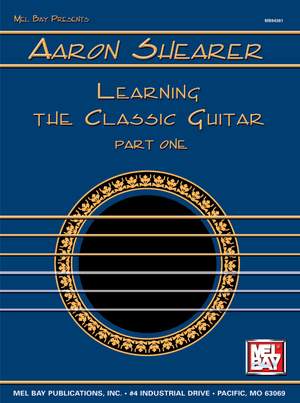Aaron Shearer: Shearer, Aaron Learning The Classic Guitar Part 1
- Author: Shearer, Aaron
- Editor: Poore, Tom
Sheet Music
$39.50Contents
- The Oassic Guitar
- "Classic'' or "Classical" Guitar?
- Tuning the Guitar
- Playing Condition of the Guitar
- Determining the Action of a Guitar
- Choosing a Teacher
- Approaching Guitar Study
- Your Goal: Sharing Music
- Essentials for Performance
- Avoiding Habits of Confusion and Error
- Aim-Directed Movement
- Developing Sustained Concentration
- Guidelines for Study and Practice
- The Four Principles of Efficient Muscle Function
- Positioning the Guitar
- General Positioning
- The Five Ways of Moving the Guitar
- The Right- and Left-Hand Position Checks
- Adjusting Your Position
- An Alternative to Using the Footstand Alone
- Tone Production
- Principles of Tone Production
- Tone Quality and Your Nails
- Nail Contours and Suggested Sha pings
- Beginning Right-Hand Training
- Terms and Symbols
- Right-Hand Positioning
- Rest-Stroke and Free-Stroke
- The Prepared-Stroke
- Training P: The Prepared Free-Stroke
- Sounding the Strings
- The Continuity-Stroke
- Beginning Left-Hand Training
- Before You Begin
- Left-Hand Positioning
- Left-Hand Movement
- Movement by Touch: Applying Aim-Directed Movement (ADM)
- Training the Right-Hand Fingers
- Training the Inactive Fingers
- The Prepared Rest-Stroke
- The Continuity Rest-Stroke
- Alternation of a Finger Rest-Stroke and r_ Free-Stroke
- Beginning Free-Stroke with Your Fingers
- Free-Stroke Considerations
- 1-M Free-Stroke
- Tip Joint Considerations
- 1-M and r_ Alternation
- 1-M-A Free-Stroke
- 1-M-A and P Alternation
- Sym pathetic Movement
- ELM
- ELM-A
- El-M,A
- Alternation
- Beginning Free-Stroke Alternation: ELM,
- Left-Hand Considerations
- EL A
- Alternating 1 and M on Adjacent Strings
- Alternating 1 and Mon a Single String
- Principles of String Crossing
- Beginning String Crossing
- Clarity on Wound Strings
- Sounding a Single Note Free-Stroke on an Adjacent String
- Mand A Alternation
- Developing Right-Hand Speed
- Developing Independence through Opposed-Finger Sweeps
- Integrating Independence and Control
- Comparing Rest-Stroke and Free-Stroke
- Rest-Stroke Finger Alternation
- Sounding Three Strings Together with r_ and the Fingers
- Sounding Two Strings Together with r_ and One Finger
- ELM,A
- ELM,&M,1
- Four Strings Simultaneously with f-1-M-A
- Further Left-Hand Training
- Applying the Principles of Efficient Muscle Function
- Developing Left-Hand Mobility
- Slurs
- Technical Slurs
- Types of Downward Slurs
- Further Right-Hand Training
- Arpeggios without P
- & MI
- LMA
- & MI,M
- I, A, MA
- & L MI
- Conditioning and Coordination Exercise
- The Importance of Stretching Exercises
- Procedure for Stretching Exercises
- Developing Muscular Coordination
- Coordination Exercises
- The Remedial Student
- Summary
- The Natural Approach
- Determining the Most Natural Approach
- The Misuse of ''Just Let It Happen"
- Economy of Movement
- Repetitive Strain Inj-ury (RSI)
- Coordination and Counterproductive Tension
- How RSI Develops
- Musicians Who Develop RSI 1
- Questions about RSI 1
- Overcoming RSI 1
- Summary 10
- Avoiding Chronic Shoulder Pain 11
- Learning to Recognize Correct Arm Movement 1
- Procedure for Training the Right Shoulder 1



